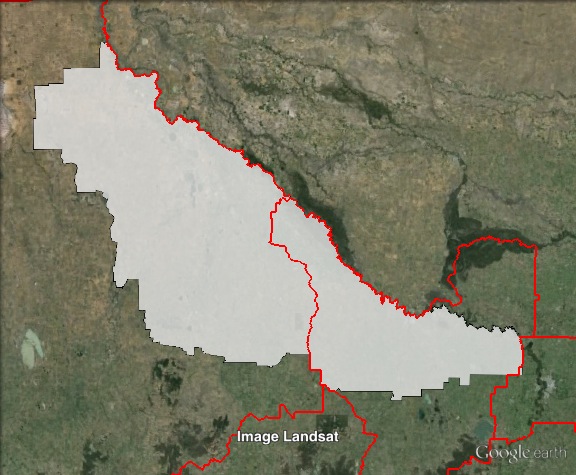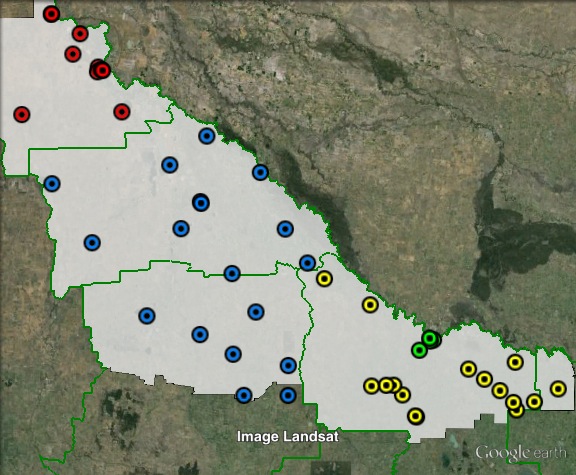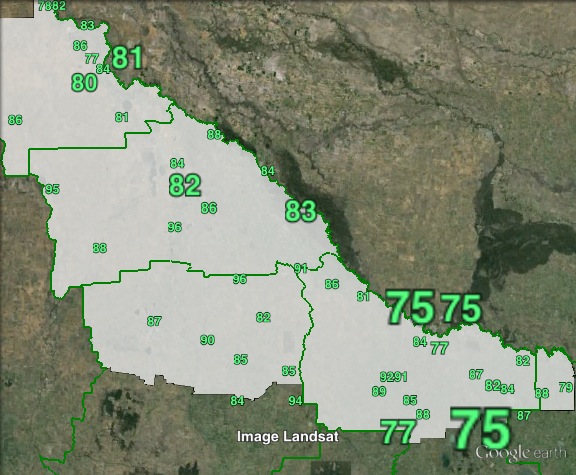NAT 30.2%
Incumbent MPs
Murray Plains takes in parts of the former electorates of Rodney and Swan Hill:
- Peter Walsh (Nationals), since 2002.
- Paul Weller (Nationals), since 2006.
Geography
North-western Victoria. Murray Plains stretches along the Murray River from Echuca to Swan Hill. Murray Plains also covers Cohuna, Kerang, Kyabram and Rochester. Murray Plains covers the entirety of the Gannawarra council area and parts of the Campaspe, Greater Shepparton, Loddon and Swan Hill council areas.

Redistribution
Murray Plains is a new electorate, taking in parts of the former electorates of Swan Hill and Rodney, including those electorates’ main centres of Swan Hill and Echuca. Echuca, Cohuna, Kyabram and Rochester were previously contained in Rodney, while Swan Hill, Kerang and Pyramid Hill were previously contained in Swan Hill. Murray Plains is estimated to have a Nationals margin of 30.2%, which makes it the safest seat in Victoria, and safer than both the former electorates in the area. Swan Hill was won in 2010 with a 29.3% margin, and Rodney was won with a 26.2% margin.
History – Rodney
Rodney has existed as a Legislative Assembly district since 1856. The seat has been held continuously by the Country/National Party since its emergence in 1917.
The seat was won in 1917 by John Allan of the Victorian Farmers Union, which became the Country Party. Allan became the party’s first leader, and served as Premier of Victoria from 1924 to 1927. He held his seat until his death in 1936.
Rodney was held by four other Country/National MPs from 1936 to 1989, when Eddie Hann resigned.
The 1989 by-election was won by Noel Maughan. He was re-elected in 1992, 1996, 1999 and 2002, and retired in 2006.
The seat was won in 2006 by Paul Weller, a former President of the Victorian Farmers Federation. Weller was re-elected in 2010.
History – Swan Hill
Swan Hill has existed as a Legislative Assembly district since 1904. It has been held by the Country/National Party for most of the period since 1917, apart from a few periods of the Liberal Party holding the seat.
The seat was won in 1917 by Percy Stewart of the Victorian Farmers Union. He resigned from Swan Hill to win the federal seat of Wimmera in 1919. He helped form the Country Party in the federal Parliament. He held Wimmera until his death in 1931.
The 1919 Swan Hill by-election was won by Francis Old. He served as deputy leader of the Country Party from 1922 to 1924 and again from 1936 to 1937. He served as a minister from 1923 to 1924 and again from 1935 to 1943, serving as Deputy Premier from 1936 to 1937. He held Swan Hill until 1945.
John Hipworth won Swan Hill for the Country Party in 1945. He switched to the Liberal Party in 1949 and managed to win re-election in 1950, but he lost his seat in 1952.
Harold Stirling held Swan Hill for the Country Party from 1952 until his death in 1968. Henry Broad won Swan Hill at the 1968 by-election, also for the Country Party.
Broad was defeated by the Liberal Party’s Alan Wood in 1973. Wood served as a minister in the state government from 1979 to 1982, and resigned from Parliament in 1983 following the defeat of the Liberal government at the 1982 election.
Barry Steggall won Swan Hill back for the National Party in 1983. He served for 19 years in Parliament, serving as deputy leader of the Nationals from 1999 until his retirement at the 2002 election.
In 2002, Swan Hill was won by Peter Walsh, a former President of the Victorian Farmers Federation running for the Nationals. He was re-elected in 2006 with a 9.25% swing, and won a third term in 2010.
Candidates
Nationals Member for Swan Hill, Peter Walsh, defeated fellow Nationals Member for Rodney, Paul Weller, for preselection for Murray Plains. Paul Weller will be running as the fourth candidate on the Liberal/National ticket for the Northern Victoria upper house region.
- Bryon Winn (Country Alliance)
- Peter Williams (Labor)
- Ian Christoe (Greens)
- Laurie Wintle (Rise Up Australia)
- Nigel Hicks (Independent)
- Peter Walsh (Nationals)
Assessment
Murray Plains is a very safe Nationals seat, indeed it is the safest seat held by any party in the upcoming election.
2010 election result
| Party | Post-redistribution estimate % |
| Nationals | 70.53 |
| Labor | 13.80 |
| Country Alliance | 6.30 |
| Family First | 5.31 |
| Greens | 4.06 |
2010 two-party-preferred result
| Party | Post-redistribution estimate % |
| Nationals | 80.16 |
| Labor | 19.84 |

Booth breakdown
Booths in Murray Plains have been divided into four areas. Polling places in the Echuca urban area have been grouped as “Echuca” while the remainder of Campaspe council area (as well as Greater Shepparton council area) have been grouped as “East”. Polling places in Gannawarra and Loddon council areas have been grouped as “Central”, while those in Swan Hill council area have also been grouped together.
The Nationals won massive majorities in these areas in 2010, ranging from 76.3% in Echuca to 85.2% in the centre of the new seat.
| Voter group | NAT 2PP % | Total | % of votes |
| East | 80.11 | 9,278 | 23.29 |
| Central | 85.22 | 7,365 | 18.49 |
| Swan Hill | 81.16 | 6,309 | 15.84 |
| Echuca | 76.26 | 6,063 | 15.22 |
| Other votes | 78.38 | 10,822 | 27.17 |



Nigel Hicks is nominated here as an independent
Peter Williams is the Labor candidate, and Ian Christoe is the Greens candidate.
Facebook page for independent Nigel Hicks
http://www.facebook.com/pages/Nigel-Hicks-Independent-Candidate-for-Murray-Plains/693351834105074
I just hope Peter Walsh is voted out. I think Nigel Hicks has the best chance of changing this safe Nat seat.